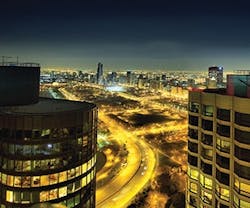Nighttime AC Increases Cooling Demand
Releasing unneeded heat from air conditioners during the night results in higher outside temperatures, increasing cooling demand and perpetuating a cycle of more waste heat from more cooling use, according to an Arizona State University study.
“We found that waste heat from air conditioning systems was maximum during the day, but the mean effect was negligible near the surface,” explains Francisco Salamanca, a post-doctoral research scientist at ASU. “However, during the night, heat emitted from air conditioning systems increased the mean air temperature by more than 1 degree C. – almost 2 degrees F. – for some urban locations.”
Using sophisticated modeling systems, the researchers simulated a 10-day period of extreme heat. They found that the AC systems’ increased effect during the night was due to the limited depth of the urban boundary layer, an area of heat and moisture exchange directly between the city and its overlying air. The boundary layer effect is strongest between late afternoon and early morning.
A smaller quantity of excess air conditioning systems ejecting heat at night can increase the air temperature more than a greater quantity of heat ejected during the day, when the hot sun is already beating down, the researchers write.
“Sustainable development and optimization of electrical consumption in cities would require turning wasted heat from AC into useful energy that can be utilized for various purposes, including water heaters,” says Salamanca. “Implementing this mitigation strategy would achieve several objectives: successfully reducing the urban heat island temperature by 1 degree C. at night, reducing AC electricity consumption on a city scale, and providing a real example of urban climate mitigation.”
